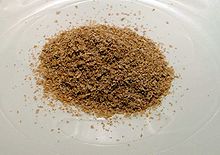**Group 1: Definition and Types of Dietary Fiber:**
– Dietary fiber is plant components not broken down by human digestive enzymes.
– The accepted definition includes all polysaccharides and lignin not digested by the human digestive tract.
– Animal nutritionists define dietary fiber as components resistant to degradation by mammalian enzymes or as non-starch polysaccharides (NSP) and lignin.
– Types of dietary fiber include soluble and insoluble fiber.
– Plant sources of fiber include dark green vegetables, legumes, whole grains, fruits, and grain bran products like crude corn bran and wheat bran.
**Group 2: Health Benefits of Soluble Fiber:**
– Soluble fiber supplements can help manage symptoms of irritable bowel syndrome.
– Prebiotic soluble fiber products may contribute to relief from inflammatory bowel diseases.
– Soluble fiber aids in producing short-chain fatty acids with anti-inflammatory actions.
– Regular intake of soluble fibers like beta-glucans can lower LDL cholesterol levels.
**Group 3: Health Benefits of Insoluble Fiber:**
– Resistant starch from high-amylose corn can improve insulin sensitivity and glycemic management.
– Insoluble fiber can promote regularity and possibly relieve diarrhea.
– Resistant corn starch may reduce symptoms of ulcerative colitis.
– Inulins are oligosaccharides with nutritional value extracted from enriched plant sources.
**Group 4: Activity and Physicochemical Properties of Dietary Fiber:**
– Dietary fibers contribute to health through bulking, viscosity, and fermentation mechanisms.
– Bulking fibers can be soluble or insoluble, increasing stool weight.
– Viscous fibers thicken intestinal contents, reducing sugar response and lipid absorption.
– Fiber fermentation produces short-chain fatty acids, influencing gene expression and metabolism.
– Dietary fiber in foods forms gel matrices and cellular structures, affected by cooking and chewing.
**Group 5: Interaction of Dietary Fiber in the Upper Gastrointestinal Tract:**
– Upper gastrointestinal contents consist of various phases and compounds after a meal.
– Micelles solubilize lipids and cholesterol in the upper gastrointestinal tract.
– Immobilization of nutrients within complex molecules affects release and absorption rates.
– Nutrients contact the epithelium through intestinal contractions and convection currents.
– Multiple physical phases slow nutrient absorption compared to suspension solvent alone.
Dietary fiber (fibre in Commonwealth English) or roughage is the portion of plant-derived food that cannot be completely broken down by human digestive enzymes. Dietary fibers are diverse in chemical composition, and can be grouped generally by their solubility, viscosity, and fermentability, which affect how fibers are processed in the body. Dietary fiber has two main components: soluble fiber and insoluble fiber, which are components of plant-based foods, such as legumes, whole grains and cereals, vegetables, fruits, and nuts or seeds. A diet high in regular fiber consumption is generally associated with supporting health and lowering the risk of several diseases. Dietary fiber consists of non-starch polysaccharides and other plant components such as cellulose, resistant starch, resistant dextrins, inulin, lignins, chitins, pectins, beta-glucans, and oligosaccharides.


Food sources of dietary fiber have traditionally been divided according to whether they provide soluble or insoluble fiber. Plant foods contain both types of fiber in varying amounts, according to the fiber characteristics of viscosity and fermentability. Advantages of consuming fiber depend upon which type of fiber is consumed and which benefits may result in the gastrointestinal system. Bulking fibers – such as cellulose and hemicellulose (including psyllium) – absorb and hold water, promoting bowel movement regularity. Viscous fibers – such as beta-glucan and psyllium – thicken the fecal mass. Fermentable fibers – such as resistant starch, xanthan gum, and inulin – feed the bacteria and microbiota of the large intestine, and are metabolized to yield short-chain fatty acids, which have diverse roles in gastrointestinal health.
Soluble fiber (fermentable fiber or prebiotic fiber) – which dissolves in water – is generally fermented in the colon into gases and physiologically active by-products, such as short-chain fatty acids produced in the colon by gut bacteria. Examples are beta-glucans (in oats, barley, and mushrooms) and raw guar gum. Psyllium – a soluble, viscous, nonfermented fiber – is a bulking fiber that retains water as it moves through the digestive system, easing defecation. Soluble fiber is generally viscous and delays gastric emptying which, in humans, can result in an extended feeling of fullness. Inulin (in chicory root), wheat dextrin, oligosaccharides, and resistant starches (in legumes and bananas), are soluble non-viscous fibers. Regular intake of soluble fibers, such as beta-glucans from oats or barley, has been established to lower blood levels of LDL cholesterol, a risk factor for cardiovascular diseases. Soluble fiber supplements also significantly lower LDL cholesterol.
Insoluble fiber – which does not dissolve in water – is inert to digestive enzymes in the upper gastrointestinal tract. Examples are wheat bran, cellulose, and lignin. Coarsely ground insoluble fiber triggers the secretion of mucus in the large intestine, providing bulking. Finely ground insoluble fiber does not have this effect and can actually have a constipating effect. Some forms of insoluble fiber, such as resistant starches, can be fermented in the colon.
